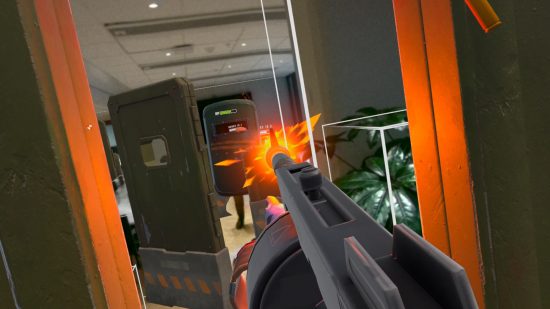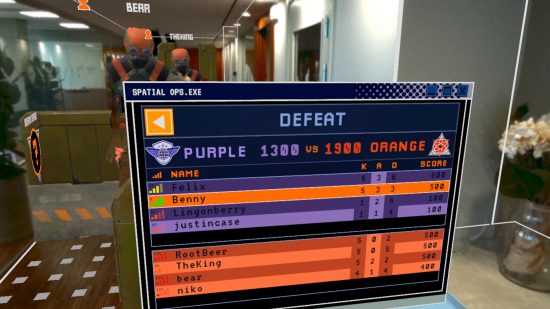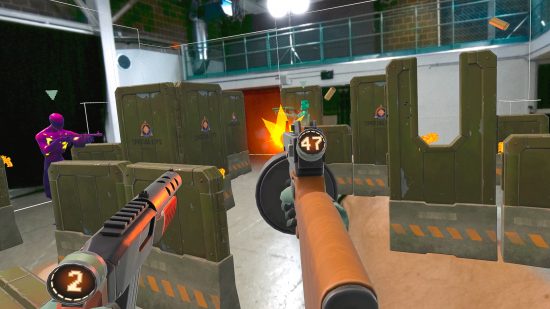Meta Quest Pro they are not your standard VR headset. Targeting commercial users with appropriate pricing hasn’t stopped developers from taking advantage. With some features not found in Meta Quest 2 (formerly Oculus Quest 2), like color pass-through or eye and face tracking, we see studios getting creative. Between Blaston, Cubism, and Demeo, more and more games feature Mixed Reality (MR), merging Virtual Reality with Augmented Reality (AR) to blend virtual gaming with the real world. Resolution Games’ Spatial Ops is perhaps the most compelling argument for MR.
With the release of Meta Quest Pro and Meta’s best VR headset, Quest 2, Resolution describes Spatial Ops as “the world’s first competitive multiplayer mixed reality shooter.” Produced by former Codename Eagle and Battlefield 1942 designer Niklas Persson, Spatial Ops transforms real worlds into a first-person shooter. Speaking with CEO Tommy Palm during a recent visit to Resolution’s office, he explained his vision, telling me, “It’s always been a dream to have a Counterstrike-like game in real life.”
With room for 1 to 8 players, I quickly tested the game on both Quest headsets for two hours with Demeo’s mixed reality update. Although combat against the AI is possible, the other participants and I played 3v3 matches in an open room. Spatial Ops achieves this through co-location, allowing the headset to recognize each other’s presence.
Although this technology is not exclusive to Quest, it allows developers to place virtual objects in specific locations within a certain area. When asked about the differences between VR and MR development, Palm said that “some things are very similar, some things are very different. You can’t do this on your computer, you have to test much more closely.”
Between digital walls and filming locations, this means that all players see the same thing, and Spatial Ops can be played anywhere. It doesn’t matter if you use an office, living room or something unconventional; you can create maps suitable for any environment. Unfortunately I couldn’t try to map the arena directly, Resolution has it all set. But once you’ve figured out the map setup and weapon spawn locations, you’re good to go.

Spatial Ops offers three game modes: there are classic Team Deathmatch and Capture The Flag modes, as well as a domination mode where you have to fight for three control points. The gaming permission isn’t pushing the boat here, but that didn’t matter. What is impressive here is the actual gameplay. Spatial Ops is like mixed reality laser tag, which isn’t surprising after Palm told me that Persson once ran a laser tag arcade. Unlike VR games, death does not take you to the spawn zone. You must physically retreat to your team’s safe zone, waiting a few seconds before returning.
Between hiding behind virtual walls, grabbing digital items, and keeping an eye on opponents, it didn’t take long to get used to. Weapons were scattered across the map: revolvers, grenades, grenade launchers, machine guns, and more. Damage shields and health items have occasionally appeared, providing additional protection as you progress. However, nothing penalizes you for crossing digital barriers, which is understandable since it would be difficult to enforce.
As someone who doesn’t play many first-person shooters, this seems like a revelation. Other than the other players, the physical space in front of me was empty, but I instinctively hid behind the virtual walls as if they were really there. Since you physically move and see your real surroundings, I never felt nauseous, as is often the case with artificial movements in VR. I couldn’t fault the mixed reality feeling and really enjoyed working with Spatial Ops.

That wouldn’t be possible with Quest’s Transfer Mode, which projects your actual surroundings through your headphones. If you’ve ever set a guardian boundary in Quest 2 to define your play space, you’ll know it. In Quest Pro, your environment is represented in color. Unsurprisingly, the Pro performs better than the Quest 2, which only supports black-and-white streaming, but I’ve never felt at a disadvantage with the old Meta headsets.
Even though he was losing almost every game, he didn’t want to stop playing and was very impressed with Spatial Ops. The only real drawback is that larger matches require larger play areas, which isn’t always practical for those playing from home. Palm admits this is a problem, calling the Spatial Focus tests “very intensive”, later admitting that “it’s hard to implement the concept in such an open landscape.”
However, there is versatility in the Spatial Ops design that demonstrates the potential for placement and streaming in mixed reality games. I felt completely immersed, more than I’ve often felt in VR shooters, and I can’t wait to try it again. Spatial Ops doesn’t have a confirmed release date, but if you want to skip it, the open beta has just started via SideQuest.
Source : PC Gamesn

